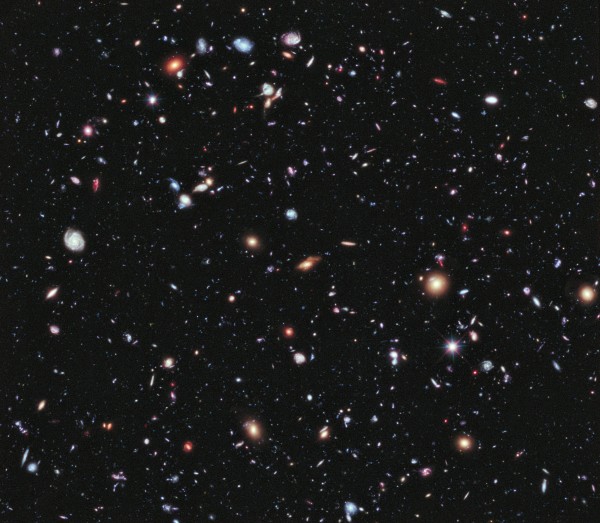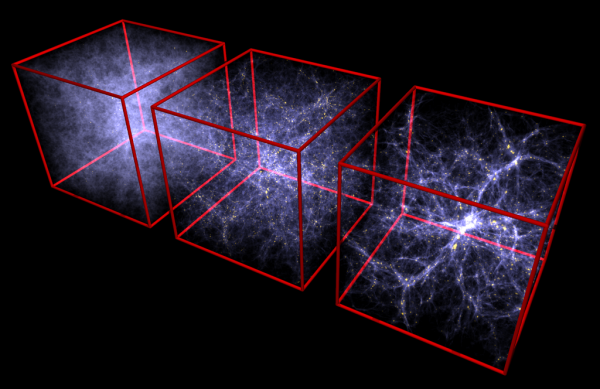"If you wish to make an apple pie from scratch, you must first invent the Universe." -Carl Sagan
The Universe is a lot like an extremely intricate cake. We view it today as a snapshot in time, now that it's complete.

Image credit: Blogger user Hilly of http://makesbakesfakes.blogspot.com/.
We can view the whole thing from one point of view, determined by where we happened to be located. But we can also look intricately inside certain sections of it, so long as we have the right tools.

Image credit: Blogger user Hilly of http://makesbakesfakes.blogspot.com/.
But if we truly want to understand it, rather than to just describe it, we need to know how the cake was made. And this doesn't merely mean that we need to know that it's got cake, filling, icing and frosting.

Image credit: Blogger user Hilly of http://makesbakesfakes.blogspot.com/.
It means we need to know all of the ingredients, and how they came to assemble, step-by-step, the cake you wind up with in the end.

Image credit: Irina of http://www.pastrypal.com/.
If we understand this properly, we should be able to come up with a perfect recipe to reproduce this cake, and both experiments and simulations should reliably reproduce a cake that looks, smells and tastes exactly like the model cake we were studying.
And this is exactly what the field of cosmology -- my field, for what it's worth -- sets out to do.

Image credit: NASA; ESA; G. Illingworth, D. Magee, and P. Oesch, University of California, Santa Cruz; R. Bouwens, Leiden University; and the HUDF09 Team.
Our Universe has been incredibly well-studied over the past century, and we now know -- down to a very intricate level of detail -- what it looks like. We know how galaxies are distributed throughout the Universe: how they clump and cluster together in groups, clusters, superclusters and along filaments.
The thing is, we also have a whole slew of other observations about the Universe, including (but not limited to) the Cosmic Microwave Background, observations of colliding galaxy clusters, the brightnesses of distant Type Ia supernovae, measurements of the abundances of the light elements, the Hubble expansion of the Universe, the age restrictions on stars, galaxies and globular clusters, the isotropy and homogeneity of the Universe on large scales, and the observed flatness and uniform temperature and density properties across billions and billions of light years.
If we really understood what was going on with the Universe, we'd be able to take our best understanding of the laws of physics, start with some initial conditions, and run a simulation that resulted in a Universe that -- aside from some normal statistical variations -- is indistinguishable, cosmologically, from the Universe we observe.

Image credit: retrieved from Peter Coles at http://telescoper.wordpress.com/2009/11/23/the-cosmic-web/.
Now, there's only one way we've ever found that gives us a "cake" that looks like our Universe:
- A Big Bang cosmology that's governed by General Relativity,
- where the energy density of the Universe is equal to the critical density,
- with roughly 4.5% of that energy density composed of normal matter (protons, neutrons and electrons),
- a small (~0.01%) amount of energy density in the form of radiation (photons),
- another small (less than 1% but maybe as much as 0.3%) amount in the form of neutrinos,
- with a large chunk (around 22%) in the form of dark matter
- and the rest (maybe 73%) in the form of dark energy.
Additionally, a number of remaining puzzles (flatness, horizon, spectral index) are solved by adding inflation as a way to set up the Big Bang.
The thing is, that's it.
The cake looks amazing, but there are still a few things that you'd prefer to be tweaked. There are a few details that don't quite match about structure formation on small scales (like, individual galaxies and smaller). There are some possible issues with the ages of some of the oldest globular clusters (that may appear to be as old as, if not a few percent older than, the age of the Universe). And... that's really it.
In other words, we've got an amazing cake that matches up, but perhaps it's a little too bitter and not quite sweet enough for the most discriminating of tastes. We'd like the cake to be a little better.

Images credit: Janet of http://www.prettytastycakes.com/2008/07/30/cosmic-dome-cake/.
There are alternative models that come out all the time that fix this problem. They are sweet enough. They aren't too bitter, either.
The big problem is this: they aren't cakes.
It's tantalizing and controversial to make a contention like Do We Really Need Dark Matter? But it's a lie, and a poor lie at that. You can't solve one minor problem at the expense of six or seven major ones, and that's what every alternative that's ever been proposed to dark matter does, including the latest one.
Yes, we don't have all the answers, and other than knowing a whole host of properties of dark matter (energy density, interacts gravitationally, no strong or electromagnetic interactions, highly restricted self-interactions and cross-sections, etc.), we aren't entirely sure what it is. But the simple fact of the matter is this: as far as we've been able to determine, we can't have the Universe we live in without it.
The next time someone proposes an alternative to dark matter, remember to hold it up to this level of scrutiny: can you reproduce the Universe -- including the CMB, the observed expansion rate, the large-scale structure, and the abundances of the light elements, just to name a few -- without it? If the answer is yes, then you do, in fact, have an amazing breakthrough! But without it, you're just trading a minor problem for multiple catastrophic ones.
As I said earlier today: You can complain that the Dark Matter cake isn't sweet enough, but a bowl of sugar is no substitute.






Ethan, I'm reading the paper (http://arxiv.org/pdf/1212.1110v1.pdf) but I don't understand in your write up what specifically is wrong with it. Do the equations not add up correctly? Is the age they suggest demonstrably wrong? I understand your article, and I love it, but the cake analogy isn't conveying to me what is lacking in the paper. The external observer bit in the paper seems off to me, but wouldn't what they assert about total-to-baryonic mass ratio adequately comply with steps 1 through 5 of your cake?
I'm not defending the paper at all, as I am unqualified to judge the validity of it. I have a hunch that this paper is outside the mainstream, but I can't adequately articulate why. Would you, or any of the readers, care to elaborate on what this paper does wrong?
Thanks!
Brad
Brad,
The things lacking from this particular paper are:
-a homogeneous Universe (a Universe that's similar here to everywhere else; their model has galaxies progressively different from our own as we move farther away),
-a significantly older Universe than our own (by about 2 billion years),
-no explanation for CMB anisotropies,
-no explanation for large-scale structure,
-incorrect predictions for big-bang nucleosynthesis.
Those are the flaws I've been able to spot. Someone with more interest in the paper may be able to find others (supernovae, perhaps?), but that's more than enough to stop caring about the idea from my point-of-view.
Thanks again, Ethan!
I'd guess there will be more and more ideas like this so long as DM continues to evade detection. You can't really blame them for trying, though... I mean, calling it a lie probably isn't appropriate. A lie is when the person knows the real answer, and is intentionally spreading misinformation--this is just a swing and a miss.
Ethan, just because we don't have a model that is cohesive without dark matter does not mean we MUST have dark matter to have a correct model. We have been working on this enigma for years and we are still no closer to solving the problem or even isolating just what dark matter is. We are just as far from understanding dark matter as the day it was proposed.
Yes we can plug it into an infinite amount of equations to balance them, and pretend like that make sense but it doesn't. We are talking about some incredible, undetectable, unquantifiable form of matter yet we somehow know how much of it there is in the universe?
Our standard model is complete. No dark matter particle. Which means dark matter is either an undiscovered state of matter or it is something else. If it was comprised of any particle on the standard model we would have detected it or at least someone would have calculated it and published a paper proving it.
We only have a few options:
- Our standard model is incomplete and there must be a particle, while impossible to detect, accounts for the massive quantities of dark matter in the universe.
- Dark Matter is some new state of matter that we do not understand, that is the most common state of matter, effecting some 90% of the universe.
- Or! Our assumptions are wrong. The speed of light is not constant throughout the universe, or the force of gravity, the spin of distant galaxies is somehow distorted to make the appear to spin faster, or something else.
We cannot hold so tightly to one idea and dismiss all others. We will accomplish nothing this way. Until dark matter is detectable, and measurable outside of empirical data then all models that account for the universe have the same validity.
"Ethan, just because we don’t have a model that is cohesive without dark matter does not mean we MUST have dark matter to have a correct model"
But until you come up with an alternative model, the model we have MUST have dark matter.
Feel free to propose an alternative model here.
"I’d guess there will be more and more ideas like this so long as DM continues to evade detection."
And as long as no detectable thought is found in posters like you, the posting of completely vacuous bollocks will continue.
Wow, you're a scumbag. That is easily detectable.
Jon, just because your brain doesn't work like a normal human doesn't mean you're right.
Go and find some orderlie and ask them to help you back to your safe little cot.
Dark Matter will never be fully understood until the solutions of the equations defining the relationship between its mere mention and the emergence of flamers have been found.
I fear you may be right, Pat.
Though I'd say rather "never acknowledged as understood". Because of the anti-DM flamers.
I think the latest paper is just crackpot nonsense. But I think Ethan's list of flaws don't make sense either. For instance, Ethan says he got the age of the universe wrong. But actually the age of the universe is a property computed in a given model, and he computed it to be different in his model than to LambdaCDM. So that is fine. It only becomes a problem when the model makes predictions in conflict with other data.and Ethan hasn't pointed out any examples of this. He has just mentioned that it is not the same as LambdaCDM, which of course is the whole point of the paper. Personally, I think the paper is nonsense, but Ethan has out it on firmer ground by not finding any real flaws.
Bob, your incorrect.
Coalsescing of the matter into the current forms takes time. Changing stars into giants takes time.
But if you take a lot more time, you have more condensed matter and fewer large stars.
These put limits on the age of the universe NOT sourced from the models you claim.
The problem with with the dark matter hypothesis is that currently dark matter is like fairy dust.
Yes, we have excellent observations that say, there is some necessary missing ingredient that is needed call it dark matter or call it fairy dust. But whatever you call it; we really need it.
This morning my first batch of pancakes turned out terrible. They were missing an ingredient. I thought a bit then added baking powder; the second batch turned out fine.
The problem with the dark matter hypothesis is this; we have dark matter observations that suggest that we are missing an ingredient, or that we are misunderstanding gravity; but we neither know what the missing ingredient is nor how to make a better theory of gravity.
So we got fairy dust or if you prefer dark matter.
Excellent, excellent observations; but no uncontended explanation (theory) that explains what we see. It reminds me of Oliver Sacks patient in his medical case study "The Man Who Mistook His Wife for a Hat". The patient's eyes worked but he had no idea what he was seeing.
We see dark matter observations but we have no idea what we are seeing.
Thanks Ethan!
I may have gone overboard on UT by giving it an "arxiv crackpot" qualification, seeing how Baez's crackpot index measures authors, not papers. But as a rule I don't know how to refer to them.
"Not even wrong" papers, a slight overinterpretation of "not cakes", is better.
@ solarspace:
"I’d guess there will be more and more ideas like this so long as DM continues to evade detection."
But the point is it _has_ been detected.
First because it is a constraint of standard cosmology and necessary for structure formation, so it is observed by way of the model experiment.
Second because of the long list of additional constraints that observations have forced, see Ethan's article: "energy density, interacts gravitationally, no strong or electromagnetic interactions, highly restricted self-interactions and cross-sections, etc." It is so constrained we can even image it routinely by gravitational lensing.
But we haven't identified the particle responsible, akin to how neutrinos were unidentified between Pauli's proposal 1930ish and their identification 1956.
The reason these ideas are proposed, like similar ideas on how selection isn't a main mechanism in evolution despite being a centuries old unambiguous identification, is because some proportion of people will always believe they can change the field. Not because it makes sense.
@ solarspace: I forgot your "more and more".
Without statistics we can't know, but my guess is it is less and less.
Because the constraints on DM are improved all the time, it is also now an unambiguous detection with alternatives to standard cosmology safely rejected, and the proportion of people that believe they can change a whole field will therefore diminish.
"So we got fairy dust or if you prefer dark matter."
Love it. From now on its Fairy Dust not DM.
Where is the gravitational effect of light in any of these models? Light has a direct gravitational effect on objects. I am not saying that light is effected by gravity but light has an effect on gravity. This is not a personal view. Light exerts gravity : in general relativity, gravity is coupled to energy density and momentum flow, not only mass like in newtonian gravity. An electromagnetic wave will exert its own gravity, though extremely weak and not currently measurable. Gravity exerted by massive bodies is much higher because of their huge energy content (see the c squared term in Einstein formula). What i see is the massive amount of electromagnet waves travelling through the universe. I have yet to see this added to the models. Am i missing something?
The maths uses mass-energy, therefore light's effect on the shape of the universe is taken into account.
At least as far as that model of reality has it.
@Brian Blow:
You indeed missed something. Look again at Ethan's article above, where he listed the ingredients of the universe. Look what percentage radiation makes up... That is not a "massive amount", that essentially negligible.
Dark matter and dark energy, as cake ingredients, are like a box of powder and a bottle of liquid bought at the store that you add to your cake mix. You have no idea what is in them; they make up the majority of your ingredients; and the cake comes out tasting good.
Whether that counts as understanding how cakes are made, I'm not so sure.
It sounds like "Dark Matter" and "Dark Energy" are just plugs to equations... am I wrong?
Maybe if our current model of the universe does not work, perhaps the model is wrong? I cannot (of course) propose an alternate, but it seems like an interesting thought.
@OKThen
"The problem with the dark matter hypothesis is this; we have dark matter observations that suggest that we are missing an ingredient, or that we are misunderstanding gravity; but we neither know what the missing ingredient is nor how to make a better theory of gravity."
True, but it's far easier to hypothesize a missing ingredient that is consistent with all the other observations -- indeed, such a missing ingredient is implied by multiple completely different lines of evidence -- than it is to come up with a revised theory of gravity that agrees with all other observations. Now that you basically need a theory of gravity where the gravity force vector is not defined by the mass/energy distribution in order to explain DM observations it's practically untenable.
So while obviously things are still up in the air so to speak "well-working hypothesis that explains everything but lacks direct detection yet" is miles ahead of "unknown theory of gravity that works in direct contradiction of everything we do know of gravity."
@Jon
"We cannot hold so tightly to one idea and dismiss all others. We will accomplish nothing this way. Until dark matter is detectable, and measurable outside of empirical data then all models that account for the universe have the same validity."
Well see that's the exact problem with all the others ideas -- they DON'T account for the universe. They don't even come close. They account for some tiny portion of the universe so you can say "Ha! We don't need Fairy Dust *here*!" but don't match anything else.
The other ideas have not been dismissed in general; there are many people working on alternative hypothesis. However it is only reasonable to favor a model that DOES explain the universe over ones that DON'T. Isn't that what you just said was the test for equal validity-- Explaining the universe equally well? Ergo models that explain the universe less well are less valid.
@Joffan
"Whether that counts as understanding how cakes are made, I’m not so sure."
Heh. Now this comment I like.
It counts as *some* level of understanding, but not one that anyone would find satisfying for sure! But still, having a good idea that you need some kind of batter to make a cake is moving in the right direction. Still, science presses on.
As Dara O'Briain said: "Science knows it doesn't know everything. Otherwise, it would stop."
:)
Speaking as a non-cosmologist, I think its perfectly reasonable to say that the best available model for the universe is one which contains this form of matter. There are others, but they aren't as good. This one isn't a lock. Ergo - best available. Of course, a 'best avaiable' explanation in science is the one you should tentatively accept until more data comes along to change your mind. So Ethan's defense of it seems IMO perfectly justifiable.
I'd also say that, again, speaking as a layman, you cosmos seemed to have made a lot of progress on it. All those limitations that Ethan mentions - that's progress. It may not be fast but heck, it was 230 years between Newton's observations on Mercury and GR, so really, I wouldn't beat yourselves up about 20-30 years of not yet finding a complete explanation.
I don't think it's "we must" for everyone.
The standard model MUST have dark matter.
The problem with the quantum gravity hypothesis is we don't have a theory yet.
The problem with the dark matter hypothesis is we either don't have a particle or we don't have an improved theory of gravity.
So we either need new particles (e.g. an extended Standard Model, i.e. eSM) or we need quantum gravity (e.g. and extension of quantum field theory to include gravity, i.e. QBD).
Maybe we just need to find and understand a new symmetry group, so we can develop a theory of QBD (Quantum Bounce Dynamics). Where Bounce (i.e. a quantum property of gravity) analogous to Color (a quantum property of the strong nuclear force).
But either way, finding a new particle or finding a new symmetry, all the physics and astrophysics that we know has to be explained by the NEW theory.
Because yes, a new particle would means a NEW theory (e.g. an extended Standard Model, eSM); just as a new symmetry would mean a NEW theory (e.g. QBD) .
Now, if we knew nothing about chemistry. We might come to the conclusion that my flat pancakes were missing a gas to make them airy and fluffy. We might try to beat the batter in such a way that more air mixes into the batter. And sure enough adding more gas to the batter might work better than adding a more solid (e.g. sand or sawdust). But the missing ingredient when found would turn out to be a solid (i.e. baking powder or baking soda). So the first candidate hypothesis, some gas (e.g. from the theory of earth, air, wind and fire) just would never work very well; but what would be found was that a long short solid hypothesis, some solid (e.g. baking powder from the new theory chemistry) would be the correct missing ingredient.
Just so we don't know if the missing ingredient from the "Dark Matter Observations" are a particle, a symmetry group, or some other theoretical/mathematical entity that makes a NEW theory (e.g. an eSM or a QBD or some other theory) that explains the observations which we can be the Dark Matter Observations or the Fairy Dust Observations.
Just as in the flat pancake observations; we could call the missing ingredient the Dark Gas or the Fairy Gas.
All this being said, these "Dark Matter Observations" are really excellent. And we really don't know if the missing ingredient will turn up in theory, experiment or observation first. But wherever that missing ingredient turns up, our understanding of "particle" and "theory" will change together.
A new particle will mean a new theory.
A new theory will mean a new understanding of particle, i.e. the meaning of particle interactions will be deeper.
Careful observations of galaxies or pancakes is never enough. We need a theory to explain what we see.
disclaimer: QBD, Quantum Bounce Dynamics appearing in this comment is fictitious. Any resemblance to real theories, accepted or conjectured, is purely coincidental.
"Careful observations of galaxies or pancakes is never enough. We need a theory to explain what we see. "
There are lots of theories out there that predict new particles that could explain Dark Matter. We just don't have any observations to let us know which, if any, are the right one.
Yes, yes.
So with only candidate theories and candidate particles; we just got very excellent fairy dust observations.
Which is to say that we are certain that we see something very important; we just have no idea what we are observing.
Not literally no idea, but sure, we don't know what it is. That's definitely true, and nobody would argue.
So what's your point?
"The most accurate study so far of the motions of stars in the Milky Way has found no evidence for dark matter in a large volume around the Sun. According to widely accepted theories, the solar neighbourhood was expected to be filled with dark matter, a mysterious invisible substance that can only be detected indirectly by the gravitational force it exerts. But a new study by a team of astronomers in Chile has found that these theories just do not fit the observational facts. This may mean that attempts to directly detect dark matter particles on Earth are unlikely to be successful... “Despite the new results, the Milky Way certainly rotates much faster than the visible matter alone can account for. So, if dark matter is not present where we expected it, a new solution for the missing mass problem must be found. Our results contradict the currently accepted models. The mystery of dark matter has just become even more mysterious. Future surveys, such as the ESA Gaia mission, will be crucial to move beyond this point.” concludes Christian Moni Bidin." Apr, 2012, http://www.eso.org/public/news/eso1217/
My point is that "Yes, we really, REALLY need (an accepted explanation of the) Dark Matter (observations)! "
But it really doesn't matter if that explanation involves new particles or new quantum gravity interactions or something else.
There are thousands of physicists, astrophysicists and mathematicians working on experiments, observations and theories that may explain the "dark matter observations". They have many working hypotheses guiding their various research.
It is presumptuous to assume that "dark matter observations" can only be explained by the "new particle beyond the standard model hypothesis". For sure that is an excellent scientific working hypothesis; but not the only excellent working hypothesis.
In science, sometimes an unknown patent clerk has revolutionary ideas that change our understanding of the world forever. The key to understanding the "dark matter observations" may depend upon such a revolutionary idea.
"It is presumptuous to assume that “dark matter observations” can only be explained by the “new particle beyond the standard model hypothesis”. "
Nobody is assuming that it must be. It's only the best hypothesis so far. So, what's your point?
"In science, sometimes an unknown patent clerk has revolutionary ideas that change our understanding of the world forever."
A patent clerk, and a graduate physics student.
People tend to forget that part.
"A patent clerk, and a graduate physics student."
And given a post lecturing at a university.
Canards like this resonate because it makes people think they are just as welcome to try their hand at science. So they don't check and the meme spreads round, each one thinking "If it were wrong, someone would have said something by now".
See "Al Gore predicted 20ft sea level rise in 20 years" for a similar example. It never happened, the only links people have are to some blog owner claiming it. No such assertion appears in any copy or transcript of the documentary.
See the Wiki link on Einstein.
Yes, of course, Einstein was both a patent clerk and studied graduate physics.
An arbitrarily dark matter hypothesis:
Dark Energy and Dark Matter like intrinsic curvature in extended gravity. Viability through gravitational waves, by Christian Corda, November 8, 2012, arXiv:1211.1373
"A definitive endorsement for the real viability of Extended Theories of Gravity could arrive from the realization of a consistent GW astronomy." So GW (gravitational wave) astronomy could test this theory. Very nice. I never heard of this one. We just need to wait for gravitational wave astronomy to work out.
Dark matter was hypothesized in 1932; now 80 years later, astrophysicists still can't explain the "dark matter observations". And after 80 years the "dark matter hypotheses" still has problems. (e.g. "“The most accurate study so far of the motions of stars in the Milky Way has found no evidence for dark matter in a large volume around the Sun." (see above) and of course no particle.
So give some breathing room to the next tier candidate hypotheses; because we do not know if "phenomena attributed to dark matter point NOT to some form of matter BUT actually to an extension of gravity?" wikipedia
So yes, maybe one of the lesser known 1000s of PhD in physics, astronomy or math working on a lesser known hypothesis will come up with a revolutionary explanation of the "dark matter observations." hint: these are my metaphorical patent clerks.
So yes, a new particle hypothesis is the best (i.e. the favorite) working hypothesis so far to explain the "dark matter observations".
But the favorite race horse only wins about 1/3 of the time.
He studied far beyond the current understanding given by the word "graduate physics".
Look, I don't think that DM can go anywhere until we have some actual real definition of what the bloody stuff is.
You could call it fairy dust if you like, but it's rather derogotory. And still doesn't describe it with any greater accuracy (indeed slightly less since there is nothing mystical about the DM theories and definitely no glowing that you get canonically from fairy dust).
Until DM is given some physical basis (as per Higgs Boson, for example), I'll count it as a placeholder for the real explanation. Whether it turns out to be a modification of spacetime curvature with large constrained masses (which would infer a greater effect at supercluster scales which may be countered by Dark Energy, natch).
"rather derogotory", considering the source; I take that as a complement.
But your summary of the DM is well said.
I agree.
"considering the source; I take that as a complement."
Ah.
You're a twat.
Sorry, forgot. I thought there was an adult on the other end of the conversation. My bad.
Lithium, boron, beryllium, carbon.
Plenty of radioactives that are way off the decay list, that we have here on earth, and they are all way past their expiration date.
Somehow magically "reset"
And that isn't even figuring in the time from formation in a supernova and recondensation thru a proto and a disc.
All WAY off.
Particle theory in QCD isnt much reproducible.
Every single meteorite or IDP is made of stuff that needs to have been mixed and heated with water - and frozen while still in particle form.
Spiral Galaxy structure, non-interacting minor irregular galaxies. Gamma rays.
I don't see a single thing in astronomy that isn't just handwavium built on someone else's fantasy. Even if a fab mathematics fever dream.
Explain neutron synthesis. Magnetism. Spin. Plasma particle beams. Gravity. String theory is maybe the worst.
How centripetal force overcomes centrifugal force, photonic pressure, and conservation of energy.
Anything.
I see ton's of papers on Arxiv, and none of them use the much ballyhooed reproduction of even basic experiments.
I see NOTHING in modern science, later than Maxwell, that has much of a solid base. We have workable models, that actually allow us to design working items, but we don't seem to have the correct laws that show how things actually ARE.
If you can't explain it to a layman, then you don't have the correct understanding yourself.
Like your analogy's tho. Always entertaining and up to date.
Question: Is Dark Matter and Dark Energy in some sort of "different polarization", such that we cannot see them, but do observe the gravitational effects of both?
Gravity can lens light from beyond a star such that it allows one to see behind large stellar masses!
Therefore it is a matter of using the correct technique to display this Dark Matter into a visible wavelength. Matter and Anti-matter mutually annihilate, so possibly therein lies a parallel situation?
Jon got it right. All you have to do is assume that gravity is not the simple function we assume and everything fits.
@GFRZ
I would say you are correct if you can provide the correct function gravity has, and if you can give links to experiments that show that "everything fits".
These, however, will not be forthcoming. It's a lot easier to say "everything fits" when you've only looked to see how it can fit where it does.
Wow: Don't be too sure. The Gravitational Constant is an average over all space-time. If the Law of Gravitation (Force proportional to 1/r^2) only works in the limit of short distances, you don't need Dark Matter and Dark Energy. That is, you don't need a pull (hidden mass) or a push (hidden radiation pressure) if "deviations" in the local Law can account for the observations. I am no Cosmologist, but "Dark" stuff just smells like "Ether" to me. P.S. The notion that force laws have long range perturbations is not new. I am not inventing something to explain recent observations. I am invoking a possible old explanation that could be tested.
"Wow: Don’t be too sure. The Gravitational Constant is an average over all space-time."
It's *asserted* as such.
I think there could *easily* be a change to the gravitational forces.
However, the effects could not be large enough to explain *all* the observed discrepancies without it being obvious that the standard gravitational theory has some extra terms in it.
e.g. my car going faster can be explained *somewhat* by a tailwind. However, the tailwind would not be able to be enough without it being *obvious* that I'm running away from hurricane-strength winds.